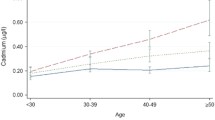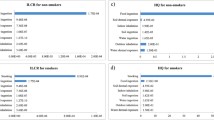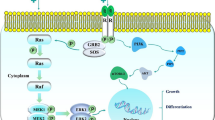Abstract
Prior investigations identified an association between low-level blood arsenic (As) and bladder cancer risk among Tunisian men but questions remain regarding confounding by cadmium (Cd), a well-established bladder carcinogen. A case–control study of Tunisian men was re-examined to assess the levels of cadmium in blood and reparse the association between the simultaneous exposure to these metals and bladder cancer risk. Levels of blood Cd were significantly twice higher among cases than in controls (P < 0.05) and were positively correlated with smoking and age. Additionally, analysis of metal levels among non-smokers according to the region of residence showed very high blood Cd and As levels for the coastal regions of Sfax and central Tunisia. After controlling for potential confounders, for low blood As levels (<0.67 μg/L), the OR for blood Cd was 4.10 (95 % CI 1.64–10.81), while for higher levels (>0.67 μg/L), it was reduced to 2.10 (CI, 1.06–4.17). Adjustment for Cd exposure did not alter the risk associated to As exposure. This study is the first to report the relationship between Cd exposure and risk of bladder cancer occurrence in interaction with smoking and As exposure. Smoking is shown to be the main exposure source to Cd in the Tunisian population but also environmental pollution seems to be responsible of Cd exposure among non-smokers. Exposure assessment studies encompassing a wider population are needed.

Similar content being viewed by others

References
Amaral AF, Cymbron T, Gärtner F, Lima M, Rodrigues AS (2009) Trace metals and over-expression of metallothioneins in bladder tumoral lesions: a case–control study. BMC Vet Res 18(5):24
Ashraf MW (2012) Levels of heavy metals in popular cigarette brands and exposure to these metals via smoking. Sci World J 729430. doi:10.1100/2012/729430
Barhoumi S, Messaoudi I, Deli T, Saïd K, Kerkeni A (2009) Cadmium bioaccumulation in three benthic fish species, Salaria basilisca, Zosterisessor ophiocephalus and Solea vulgaris collected from the Gulf of Gabes in Tunisia. J Environ Sci (China) 21(7):980–4
Baris D, Karagas MR, Verrill C, Johnson A, Andrew AS, Marsit CJ et al (2009) A case–control study of smoking and bladder cancer risk: emergent patterns over time. J Natl Cancer Inst 101(22):1553–1561. doi:10.1093/jnci/djp361
Batáriová A, Spevácková V, Benes B, Cejchanová M, Smíd J, Cerná M (2006) Blood and urine levels of Pb, Cd and Hg in the general population of the Czech Republic and proposed reference values. Int J Hyg Environ Health 209(4):359–366
Bates MN, Rey OA, Biggs ML, Hopenhayn C, Moore LE, Kalman D, Steinmaus C, Smith AH (2004) Case–control study of bladder cancer and exposure to arsenic in Argentina. Am J Epidemiol 159(4):381–389
Cancer Registry in Southern Tunisia (2002) Cancer incidence for the years 1997–1999. Available on http://www.insp.nat.tn/fr/unite_the/regis/inci97.99b.pdf
Chen CJ, Chen CW, Wu MM, Kuo TL (1992) Cancer potential in liver, lung, bladder and kidney due to ingested inorganic arsenic in drinking water. Br J Cancer 66(5):888–892
Chen Y, Graziano JH, Parvez F, Hussain I, Momotaj H, van Geen A, Howe GR, Ahsan H (2006) Modification of risk of arsenic-induced skin lesions by sunlight exposure, smoking, and occupational exposures in Bangladesh. Epidemiology 17(4):459–467
Choura M (2008) Environmental assessment of the processing activity of phosphate in the Southern coastal area of Grand Sfax: Prospects for development and rehabilitation. SMAP III Project (Tunisia 2006–2008) Strategy of Integrated Southern Coastal Zone of Grand Sfax. Interim Report 2008. In French. Available on http://www.medcities.org/docs/Evaluation%20environnementale%20SIAPE-provisoire.pdf
Chowdhury BA, Chandra RK (1987) Biological and health implications of toxic heavy metal and essential trace element interactions. Prog Food Nutr Sci 11(1):55–113
Díaz-Barriga F, Llamas E, Mejía JJ, Carrizales L, Santoyo ME, Vega-Vega L, Yáñez L (1990) Arsenic–cadmium interaction in rats. Toxicology 64(2):191–203
Drake EN, Sky-peck HH (1989) Discriminant analysis of trace element distribution in normal and malignant human tissues. Cancer Res 49:4210–4215
El Ati-Hellal M, Hedhili A, Hellal F, Boujlel K, Dachraoui M, Bousnina M, Ghorbel H, Ndhif M (2005) Lead and cadmium concentrations in seawater and algae of the Tunisian coast. Arch Inst Pasteur Tunis 82(1–4):75–82
El Kihel B (1995) Impact of discharges of phosphogypsum in the Gulf of Gabes: geochemistry of heavy metals in sediments. PhD Dissertation, Univ of Tunis II, p86
Feki-Tounsi M, Olmedo P, Gil F, Khlifi R, Mhiri MN, Rebai A, Hamza-Chaffai A (2012) Low-level arsenic exposure is associated with bladder cancer risk and cigarette smoking: a case–control study among men in Tunisia. Environ Sci Pollut Res Int. doi:10.1007/s11356-012-1335-9
Gargouri D, Azri C, Serbaji MM, Jedoui Y, Montacer M (2011) Heavy metal concentrations in the surface marine sediments of Sfax Coast, Tunisia. Environ Monit Assess 175(1–4):519–530
Gil F, Capitán-Vallvey LF, De Santiago E, Ballesta J, Pla A, Hernández AF, Gutiérrez-Bedmar M, Fernández-Crehuet J, Gómez J, López-Guarnido O, Rodrigo L, Villanueva E (2006) Heavy metal concentrations in the general population of Andalusia, South of Spain: a comparison with the population within the area of influence of Aznalcóllar mine spill (SW Spain). Sci Total Environ 372(1):49–57
Gil F, Hernández AF (2009) Significance of biochemical markers in applied toxicology. In: Ballantyne B, Marrs TC, Syversen T (eds) General and Applied Toxicology, vol 2. Wiley, Chichester, pp 847–858
Gil F, Pla A (2001) Biomarkers as biological indicators of xenobiotic exposure. J Appl Toxicol 21:245–255
Hamza-Chaffai A (1993) Study of metal bioaccumulation and metallothionein in fish from the coast of Sfax (Gulf of Gabes), PhD Dissertation. Univ of Sfax, pp 157
Huang YL, Sheu JY, Lin TH (1999) Association between oxidative stress and changes of trace elements in patients with bladder cancer. Clin Biochem 32(2):131–136
IARC (1993) Cadmium and cadmium compounds. IARC Monogr Eval Carcinog Risks Hum 58:119–237
IEH Report on factors affecting the absorption of toxic metals from the diet (1998) Report R8. Medical Research Council. Institute for Environment and Health. University of Leicester, UK. Available on http://www.cranfield.ac.uk/health/researchareas/environmenthealth/ieh/ieh%20publications/r8.pdf
Illou S, Serbaji MM, Montacer M, Medhioub K (1996) Study of surface sediments of the northern coast of the city of Sfax-trace metals pollution, National Colloquium of Earth Sciences, Boumerdes, Algeria 20–21 May 1996
Illou S (1999) Impact of domestic and industrial telluric discharges on coastal environments: case of the northern coast of Sfax City (Tunisia). PhD dissertation. Sfax University. Tunisia
Jiang G, Gong Z, Li XF, Cullen WR, Le XC (2003) Interaction of trivalent arsenicals with metallothionein. Chem Res Toxicol 16(7):873–880
Johnson AM, O’Connell MJ, Miyamoto H, Huang J, Yao JL, Messing EM, Reeder JE (2008) Androgenic dependence of exophytic tumor growth in a transgenic mouse model of bladder cancer: a role for thrombospondin-1. BMC Urol 8:7
Joseph P (2009) Mechanisms of cadmium carcinogenesis. Toxicol Appl Pharmacol 238(3):272–9. doi:10.1016/j.taap.2009.01.011
Kellen E, Zeegers MP, Hond ED, Buntinx F (2007) Blood cadmium may be associated with bladder carcinogenesis: the Belgian case–control study on bladder cancer. Cancer Detect Prev 31(1):77–82
Marsit CJ, Karagas MR, Schned A, Kelsey KT (2006) Carcinogen exposure and epigenetic silencing in bladder cancer. Ann N Y Acad Sci 1076:810–821
Mink PJ, Alexander DD, Barraj LM, Kelsh MA, Tsuji JS (2008) Low-level arsenic exposure in drinking water and bladder cancer: a review and meta-analysis. Regul Toxicol Pharmacol 52(3):299–310
Moszczyński P, Zabiński Z, Moszczyński P Jr, Rutowski J, Słowiński S, Tabarowski Z (2001) Immunological findings in cigarette smokers. Toxicol Lett 118(3):121–127
Mrizak D, B’chir F, Jaidane M, Jean Arnaud M, Saguem S (2011) Effects of change in smoking habits on bladder cancer incidence in Tunisia. Health. doi:10.4236/health.2011.310103
Olmedo P, Pla A, Hernández AF, López-Guarnido O, Rodrigo L, Gil F (2010) Validation of a method to quantify chromium, cadmium, manganese, nickel and lead in human whole blood, urine, saliva and hair samples by electrothermal atomic absorption spectrometry. Anal Chim Acta 5;659(1–2):60–67
Olsson IM, Bensryd I, Lundh T, Ottosson H, Skerfving S, Oskarsson A (2002) Cadmium in blood and urine—impact of sex, age, dietary intake, iron status, and former smoking-association of renal effects. Environ Health Perspect 110(12):1185–1190
Parkin DM, Pisani P, Ferlay J (1994) At least one of seven cases of cancer is caused by smoking. Global estimate for 1985. Int J Cancer 59:494–504. doi:10.1002/ijc.2910590411
Pelluchi C, Bosetti C, Negri E, Malvezzi M, La Vecchia C (2006) Mechanisms of disease: the epidemiology of bladder cancer. Nat Clin Pract Urol 3:327–340. doi:10.1038/ncpuro0510
Pizent A, Jurasović J, Telišman S (2001) Blood pressure in relation to dietary calcium intake, alcohol consumption, blood lead, and blood cadmium in female nonsmokers. Journal of Trace Elements in Medicine and Biology 15(2–3):123–130
Stämpfli MR, Anderson GP (2009) How cigarette smoke skews immune responses to promote infection, lung disease and cancer. Nat Rev Immunol 9:377–384
Smith AH, Hopenhayn-Rich C, Bates MN, Goeden HM, Hertz-Picciotto I, Duggan HM, Wood R, Kosnett MJ, Smith MT (1992) Cancer risks from arsenic in drinking water. Environ Health Perspect 97:259–267
Viana GF, Garcia KS, Menezes-Filho JA (2011) Assessment of carcinogenic heavy metal levels in Brazilian cigarettes. Environ Monit Assess 181(1–4):255–265. doi:10.1007/s10661-010-1827-3
Wu CC, Pu YS, Wu HC, Yang CY, Chen YC (2011) Reversed association between levels of prostate specific antigen and levels of blood cadmium and urinary cadmium. Chemosphere 83(8):1188–1191. doi:10.1016/j
Acknowledgments
Authors express their sincere thanks to the medical staff in Sfax Hospital who facilitated sampling procedures and data collection on the subjects of the study. Acknowledgements are also addressed to the technical team in the Department of Toxicology and Legal Medicine, Faculty of Medicine of Granada for their considerable assistance in the analysis of metals.
Disclosure statement
The study received ethics approval. Funding was provided by the Ministry of High Education and Scientific research in Tunisia. The funders had no role in study design, data collection and analysis, decision to publish, or preparation of the manuscript. The authors have no competing financial interests to report.
Author information
Authors and Affiliations
Corresponding author
Additional information
Responsible editor: Philippe Garrigues
Rights and permissions
About this article
Cite this article
Feki-Tounsi, M., Olmedo, P., Gil, F. et al. Cadmium in blood of Tunisian men and risk of bladder cancer: interactions with arsenic exposure and smoking. Environ Sci Pollut Res 20, 7204–7213 (2013). https://doi.org/10.1007/s11356-013-1716-8
Received:
Accepted:
Published:
Issue Date:
DOI: https://doi.org/10.1007/s11356-013-1716-8



